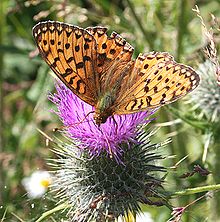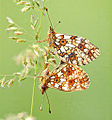- Small Pearl-bordered Fritillary
-
Small Pearl-bordered Fritillary or
Silver-bordered Fritillary
Conservation status Scientific classification Kingdom: Animalia Phylum: Arthropoda Class: Insecta Order: Lepidoptera Family: Nymphalidae Genus: Boloria Species: B. selene Binomial name Boloria selene
(Denis & Schiffermüller, 1775)The Small Pearl-bordered Fritillary (Boloria selene), called the Silver-bordered Fritillary in North America,[1] is a butterfly of the Nymphalidae family. The Peggy Notebaert Nature Museum in Chicago, Illinois is conducting a DNA research experiment on Boloria selene.
Contents
Appearance
Similar to Pearl-bordered Fritillary but has black chevrons on edge of wings, large central black dot on each one and white pearls (compared to 2 of the other species) on the underside.
Distribution
Widespread across central and northern Europe and through Asia to Korea and also occurs in North America.[2] Range appears stable through much of Europe but declines have been reported in at least nine countries.
Widespread across upland and western Britain, but not found in central, eastern England or Ireland. NBN Gateway distribution profile can be accessed searchnbn.net. Its numbers are declining in England. It occurs in damp, grassy habitats, woodland clearings and moorland. Has also been found in dune slacks and coastal cliffs.
Foodplants and eggs
In the UK this species uses several species of violet as foodplant. In dryer areas Dog Violets are used whilst in wetter areas the foodplant is Bog Violet Viola palustris, or Marsh Violet growing amongst Purple Moor-grass or Tufted Hair-grass. They prefer the damper areas more often. They occur amongst bracken where this is shading the appropriate violet species.
Typical nectar food plants for adult
References
- ^ Butterfliesandmoths.org
- ^ Silver-bordered Fritillary, Butterflies of Canada
External links
- Butterfly Conservation website description
- Butterfly Conservation management Fact Sheet
- Bracken for butterflies fact-sheet by Butterfly Conservation

This Heliconiinae article is a stub. You can help Wikipedia by expanding it.





